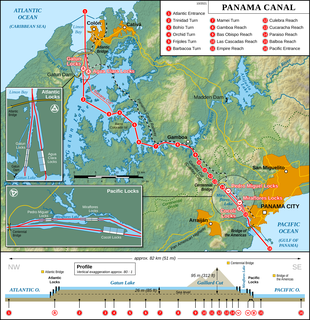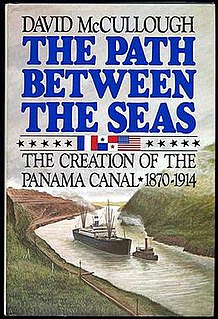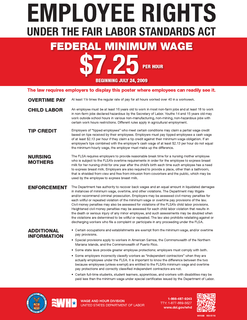Related Research Articles

The Panama Canal is an artificial 82 km (51 mi) waterway in Panama that connects the Atlantic Ocean with the Pacific Ocean. The canal cuts across the Isthmus of Panama and is a conduit for maritime trade. Canal locks are at each end to lift ships up to Gatun Lake, an artificial lake created to reduce the amount of excavation work required for the canal, 26 m (85 ft) above sea level, and then lower the ships at the other end. The original locks are 32.5 m (110 ft) wide. A third, wider lane of locks was constructed between September 2007 and May 2016. The expanded canal began commercial operation on June 26, 2016. The new locks allow transit of larger, neo-Panamax ships, capable of handling more cargo.

The history of the United States from 1865 until 1918 covers the Reconstruction Era, the Gilded Age, and the Progressive Era, and includes the rise of industrialization and the resulting surge of immigration in the United States. This article focuses on political, economic, and diplomatic history.

The Panama Canal Zone was an unincorporated territory of the United States from 1903 to 1979, centered on the Panama Canal and surrounded by the Republic of Panama. The zone consisted of the canal and an area generally extending five miles (8.0 km) on each side of the centerline, excluding Panama City and Colón, which otherwise would have been partly within the limits of the Zone. Its border spanned three of Panama's provinces. When reservoirs were created to assure a steady supply of water for the locks, those lakes were included within the Zone.
One of the greatest challenges facing the builders of the Panama Canal was dealing with the tropical diseases rife in the area. The health measures taken during the construction contributed greatly to the success of the canal's construction. These included general health care, the provision of an extensive health infrastructure, and a major program to eradicate disease-carrying mosquitoes from the area.
The National Labor Union (NLU) was the first national labor federation in the United States. Founded in 1866 and dissolved in 1873, it paved the way for other organizations, such as the Knights of Labor and the AFL. It was led by William H. Sylvis and Andrew Cameron.

The idea of the Panama canal dates back to 1513, when Vasco Núñez de Balboa first crossed the isthmus. The narrow land bridge between North and South America houses the Panama Canal, a water passage between the Atlantic and Pacific Oceans. The earliest European colonists recognized this potential, and several proposals for a canal were made.

The Path Between the Seas: The Creation of the Panama Canal, 1870–1914 (1977) is a book by the American historian David McCullough, published by Simon & Schuster. The 698-page book contains 80 photographs, two maps and extensive source references. It won the U.S. National Book Award in History, the Francis Parkman Prize, the Samuel Eliot Morison Award, and the Cornelius Ryan Award.
On February 19, 1862, the 37th United States Congress passed An Act to Prohibit the "Coolie Trade" by American Citizens in American Vessels. The act, which would be called the Anti-Coolie Act of 1862 in short, was passed by the California legislature in an attempt to appease rising anger among white laborers about salary competition created by the influx of Chinese immigrants at the height of the California gold rush. The act sought to protect white laborers by imposing a monthly tax on Chinese immigrants seeking to do business in the state of California.
A two-tier system is a type of payroll system in which one group of workers receives lower wages and/or employee benefits than another.

Cristóbal is a port town and county in Colón District, Colón Province, Panama with a population of 49,422 as of 2010. It is located on the western edge of Manzanillo Island, on the Atlantic side of the Panama Canal. Cristóbal Colón is the Spanish translation for Christopher Columbus, the Genovese explorer for whom these places were named.
The Sons of Vulcan was an American labor union which existed from 1858 until 1876. The union recruited puddlers, skilled craftsmen who manipulated pig iron to create steel. In the 1870s, it was the strongest union in the United States. It merged with two other iron and steel unions in 1876 to form the Amalgamated Association of Iron and Steel Workers—the forerunner of the United Steelworkers.

The Fair Labor Standards Act of 1938 29 U.S.C. § 203 (FLSA) is a United States labor law that creates the right to a minimum wage, and "time-and-a-half" overtime pay when people work over forty hours a week. It also prohibits employment of minors in "oppressive child labor". It applies to employees engaged in interstate commerce or employed by an enterprise engaged in commerce or in the production of goods for commerce, unless the employer can claim an exemption from coverage.

The Davis–Bacon Act of 1931 is a United States federal law that establishes the requirement for paying the local prevailing wages on public works projects for laborers and mechanics. It applies to "contractors and subcontractors performing on federally funded or assisted contracts in excess of $2,000 for the construction, alteration, or repair of public buildings or public works".
Afro-Panamanians are Panamanians of African descent. The Afro-Panamanian population can be mainly broken into one of two categories "Afro-Colonials", Afro-Panamanians descended from slaves brought to Panama during the colonial period, and "Afro-Antilleans," West Indian immigrant-descendants with origins in Trinidad, Martinique, Saint Lucia, Guadeloupe, Dominica, Grenada, Haiti, Barbados and Jamaica, whose ancestors were brought in to build the Panama Canal. Afro-Panamanians can be found in the towns and cities of Colón, Cristóbal and Balboa, the Río Abajo area of Panama City, the Canal Zone and the province of Bocas del Toro.
The United Public Workers of America (1946–1952) was an American labor union representing federal, state, county, and local government employees. The union challenged the constitutionality of the Hatch Act of 1939, which prohibited federal executive branch employees from engaging in politics. In United Public Workers of America v. Mitchell, 330 U.S. 75 (1947), the Supreme Court of the United States upheld the Hatch Act, finding that its infringement on the Constitutional rights was outweighed by the need to end political corruption. The union's leadership was Communist, and in a famous purge the union was ejected from its parent trade union federation, the Congress of Industrial Organizations, in 1950.
The economic impact of illegal immigrants in the United States is challenging to measure, and politically contentious. Research shows that illegal immigrants increase the size of the U.S. economy/contribute to economic growth, enhance the welfare of natives, contribute more in tax revenue than they collect, reduce American firms' incentives to offshore jobs and import foreign-produced goods, and benefit consumers by reducing the prices of goods and services. Economists estimate that legalization of the illegal immigrant population would increase the immigrants' earnings and consumption considerably, and increase U.S. gross domestic product.
Although bananas have been planted for thousands of years, the development of an intercontinental trade in bananas had to wait for the convergence of three things: modern rapid shipping (steamships), refrigeration, and railroads. These three factors converged in the Caribbean in the 1870s, and would lead to the development of large-scale banana plantations, usually owned and operated by highly integrated large corporations such as Dole and Chiquita Brands International.
In the United States, despite the efforts of equality proponents, income inequality persists among races and ethnicities. Asian Americans have the highest median income, followed by White Americans, Latino Americans, African Americans, and Native Americans. A variety of explanations for these differences have been proposed—such as differing access to education, two parent home family structure, high school dropout rates and experience of discrimination—and the topic is highly controversial.

The history of Panama during World War II begins in 1939. Due to the American-controlled Panama Canal cutting across the center of the country, Panama was of major strategic importance to the Allied war effort, as well as the most important strategic location in Latin America during World War II. It provided an invaluable link between the Atlantic and Pacific Oceans that was vital to both commerce and the defense of the Western Hemisphere. Therefore, the defense of the Canal Zone was the United States' chief concern in the American Theater. Panama never received Lend-Lease assistance, but in return for the rights to build military infrastructure within Panamanian territory, the United States undertook large-scale public works projects, which did much to modernize the country and boost the economy.

After U.S. President William McKinley was assassinated in 1901, Theodore Roosevelt became the new U.S. President. Roosevelt's first term was notable for his trust busting, his successful arbitration in and resolution of a 1902 strike of 150,000 Pennsylvania coal miners, his advocacy against lynching, his conservation efforts, and the Panama Canal Treaty. In 1904, Roosevelt easily defeated Bourbon Democrat Alton Parker and won a second term as U.S. President.
References
- McCullough, David. The Path between the Seas: The Creation of the Panama Canal, 1870–1914, New York 1977. ISBN 978-0-671-24409-5.
- Parker, Matt. Panama Fever: The Epic Story of the Building of the Panama Canal, New York 2007. ISBN 978-1-4000-9518-6.